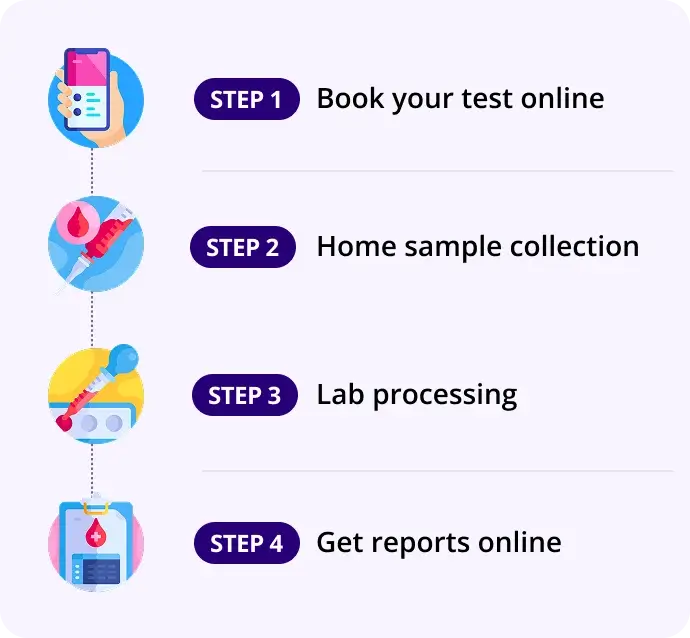Lipid Profile
Profile
8 parameters
Report in 16Hrs
At Home
Fasting Required
Details
Measures cholesterol, triglycerides, HDL, LDL.
₹219₹499
56% OFF
Test Overview
• Liver Fibrosis Markers – if chronic disease is suspected
Test Name Fasting Required? What It Measures Clinical Relevance Ideal/Target Range
- Total Cholesterol
- Fasting: Preferred
- Measures: The total amount of cholesterol (HDL + LDL + VLDL) in the blood
- High levels are associated with increased heart disease risk
- Low levels can be seen in malnutrition or liver disease
- Ideal Range:< 200 mg/dL
- HDL
– Cholesterol (High-Density Lipoprotein
- Fasting: Preferred
- Measures: “Good” cholesterol that helps remove excess cholesterol from arteries
- Higher HDL = better cardiovascular protection
- Ideal Range:
- Men: > 40 mg/dL
- Women: > 50 mg/dL
- Optimal: > 60 mg/dL (protective)
- LDL
– Cholesterol (Low-Density Lipoprotein)
- Fasting: Yes
- Measures: “Bad” cholesterol that contributes to plaque buildup in arteries
- Elevated LDL = major risk factor for atherosclerosis and heart attack
- Ideal Range:
- < 100 mg/dL = Optimal
- 100–129 mg/dL = Near optimal
- 130–159 mg/dL = Borderline high
- ≥160 mg/dL = High
- VLDL – Cholesterol (Very Low-Density Lipoprotein)
- Fasting: Yes
- Measures: Transports triglycerides; precursor to LDL
- High VLDL = increased triglyceride-rich particles → heart risk
- Ideal Range:2–30 mg/dL
- Triglycerides
- Fasting: Yes (strict 9–12 hours)
- Measures: Fat in the blood used for energy storage
- High levels = risk for heart disease, pancreatitis, insulin resistance
- Ideal Range:
- <150 mg/dL = Normal
- 150–199 mg/dL = Borderline
- 200–499 mg/dL = High
- ≥500 mg/dL = Very high
- Non-HDL
Cholesterol
- Fasting: Preferred
- Measures: Total cholesterol minus HDL (includes all “bad” particles: LDL, VLDL, IDL)
- Better predictor of heart disease than LDL alone
- Ideal Range:<130 mg/dL (or 30 mg/dL higher than LDL target)
- Cholesterol / HDL Ratio
- Fasting: Preferred
- Measures: Balance between total cholesterol and protective HDL
- Lower ratio = lower risk
- Ideal Ratio:< 4.5 (optimal <3.5)
- LDL
/ HDL Ratio
- Fasting: Yes
- Measures: Balance between bad and good cholesterol
- More accurate than LDL alone in predicting atherosclerosis risk
- Ideal Ratio:
- < 2.5 = Optimal
- > 3.5 = High risk
Summary Table
| Lipid Marker | "Good" or "Bad" | Main Risk Associated With | Optimal Value |
|---|---|---|---|
| Total Cholesterol | Neutral | Overall risk marker | < 200 mg/dL |
| HDL – Cholesterol | Good | Low HDL = higher risk | > 40 (men), > 50 (women) |
| LDL – Cholesterol | Bad | Atherosclerosis, heart attack | < 100 mg/dL |
| VLDL – Cholesterol | Bad | Triglyceride-rich particle risk | 2–30 mg/dL |
| Triglycerides | Bad | Pancreatitis, metabolic syndrome | < 150 mg/dL |
| Non-HDL Cholesterol | Bad | Total atherogenic burden | < 130 mg/dL |
| Chol/HDL Ratio | Composite | Cardiovascular risk | < 4.5 |
| LDL/HDL Ratio | Composite | Atherosclerosis risk | < 2.5 |
Recommended Conjunctive Tests
| If Lipids Are Abnormal | Additional Tests to Consider |
|---|---|
| High LDL or Triglycerides | Apo B, Apo A1, Lp(a), Homocysteine |
| Low HDL | Apo A1, hs-CRP, metabolic syndrome panel |
| Borderline/High Triglycerides | HbA1c, Fasting Glucose, Liver Function Tests (ALT, GGT) |
| Strong Family History | Genetic lipid profile, Lp(a), Apo B/A1 Ratio |
How our test process works!

